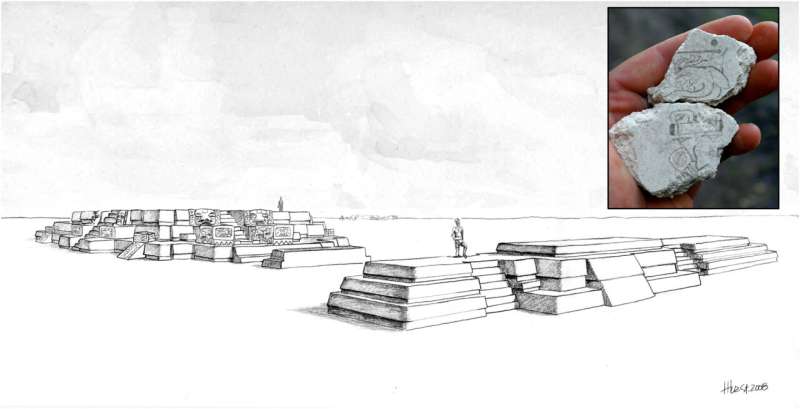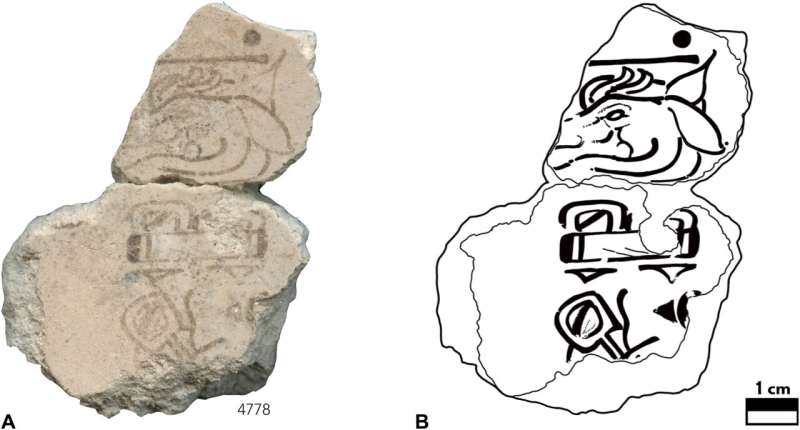Anthropology
Related: About this forumEarliest evidence of a Maya sacred calendar found in Guatemala
APRIL 14, 2022 REPORT
by Bob Yirka , Phys.org

Reconstruction of San Bartolo Sub-V phase architectural complex and the 7 Deer day-sign mural fragments associated with this context.Reconstruction view of the San Bartolo Sub-V phase architecture (300 to 200 BCE) showing radial structure, miniature ballcourt, and elongated platform referred to as structure Ixbalamque that together form an E-group. Drawing by Heather Hurst. Inset: Example of two mural fragments (consolidated as #4778), the 7 Deer day-sign and partial hieroglyphic text, among a total of 249 fragments of painted plaster and painted masonry blocks collected during archaeological excavations of the Ixbalamque context. Photograph by Karl Taube, courtesy of the Proyecto Regional Arqueológico San Bartolo-Xultun. Credit: Science Advances (2022). DOI: 10.1126/sciadv.abl9290
Researchers David Stuart from the University of Texas at Austin, Heather Hurst and Boris Beltrán from Skidmore College and independent scholar William Saturno report the earliest evidence of a Maya sacred calendar in Guatemala. In their paper published in the journal Science Advances, the group describes their work, which involved sifting through painted mural fragments at the Las Pinturas pyramid complex in Guatemala, and how they found the calendar.
The Las Pinturas pyramid complex is located near San Bartolo and has been the site of excavation for a number of years. Prior research has shown construction at the site began 2,300 to 2,200 years ago and that the pyramids at the site were built in multiple phases. As each phase of the project was completed, parts of the old structure were knocked down. As the pyramids grew in size, the pieces of the knocked-down structures remained hidden inside, providing a timeline of sorts of the construction of the complex. In this new effort, the researchers found the calendar fragments while sifting through the pieces of a wall, decorated by the Maya of that period, that had been knocked down. Dating of charcoal fragments—found in the same layer of debris as the wall fragments—showed them to be from approximately 300 and 200 BCE, making them the oldest known samples of a Maya sacred calendar.

More:
https://phys.org/news/2022-04-earliest-evidence-maya-sacred-calendar.html
Judi Lynn
(164,027 posts)The glyph found at an archeological site in the jungles of northern Guatemala dates from the third century BC. Before this, the earliest calendar notation dated to the first century BC.
April 14, 2022, 10:37 AM CDT / Source: Reuters
By Reuters
A glyph representing a day called “7 Deer” on mural fragments dating from the third century BC found inside the ruins of a pyramid in Guatemala marks the earliest-known use of the Maya calendar, one of this ancient culture’s renowned achievements.
The fragments were found at the San Bartolo archeological site in the jungles of northern Guatemala, which gained fame with the 2001 discovery of a buried chamber with elaborate and colorful murals dating to about 100 BC depicting Maya ceremonial and mythological scenes, researchers said on Wednesday.
The pieces with the “7 Deer” glyph were unearthed inside the same Las Pinturas pyramid where the still-intact later murals were located. As was the case with this structure, the Maya often built what initially were modest-sized temples, then constructed ever-larger versions atop the earlier ones. This pyramid eventually reached about 100 feet (30 meters) tall.
The glyph found on the mural fragments for “7 Deer,” one of the calendar’s 260 named days, consisted of the ancient Maya writing for the number seven over the outline of a deer’s head.
More:
https://www.nbcnews.com/news/latino/earliest-evidence-maya-calendar-found-guatemalan-pyramid-rcna24402
Judi Lynn
(164,027 posts)Duration: 01:10 4 hrs ago
- video at link -
https://www.microsoftnewskids.com/en-us/kids/video/the-mayan-end-of-the-world-calendar-has-just-revealed-another-surprise-about-the-ancient-people/vi-AAWeGEZ
Judi Lynn
(164,027 posts)This is the oldest known use of the Maya calendar
It was almost destroyed by a construction project 2,200 years ago.
KIONA N. SMITH - 4/15/2022, 10:07 AM

An artist's sketch of what the 300-200 BCE temple complex at San Bartolo looked like in its heyday.
Stuart et al. 2022
Amid rubble buried beneath a Maya pyramid in Northern Guatemala, archaeologists found a broken bit of plaster with a glyph painted on it. A bar-and-dot symbol for the number “7” is drawn above a deer head, representing “7 Deer,” a date in the 260-day Maya calendar system. At around 2,300 years old, the painted plaster is the oldest known use of the calendar system once used by cultures across Mesoamerica, including the Aztec and the Maya—and still used by many Maya communities today.
“Its persistence in many communities up to the present day stands as a testament of its importance in religious and social life,” wrote University of Texas archaeologist David Stuart and his colleagues in their recent paper about the glyph. “Our ability to trace its early use back some 23 centuries stands as another testament to its historical and cultural significance."
7 Deer, 2,300 years ago
The Maya calendar combines the numbers 1 through 13 with 20 words for animals, plants, or concepts. Those 20 words rotate in a set order; for instance, Deer is always followed by Rabbit, Water, Dog, Monkey, and Grass. When the numbers paired with the days reach 13, they start over, so 13 Rabbit would be followed by 1 Water, 2 Dog, and so on. (Pop quiz: What’s the day after 7 Deer?)
Eventually, that system produces 260 combinations of numbers and words. But here’s where things get slightly complicated because a Maya year still lasted 365 days. The first day of the year could fall on any day whose name included a “Year-Bearer,” one of the animals, plants, or concepts allowed to start a new year. Think of it as similar to the way New Year’s Day can fall on any day of the week in our system; the year can start on a Tuesday or a Friday with no problem.
More:
https://arstechnica.com/science/2022/04/this-is-the-oldest-known-use-of-the-maya-calendar/